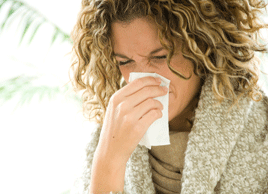
Things that make you go “hmmm”
Do you ever wonder if some of the strange things that your body does are “normal” quirks, or a sign of poor health? Why is it that when you dig into a bowl of steaming hot soup or spicy chili, your nose suddenly starts to run like crazy? And why does your pee smell funny after you’ve eaten a few pieces of asparagus? Sometimes our bodies do things that seem downright weird, but we’re afraid to ask our doctor about them because, well, they’re just plain embarrassing.
So, Best Health turned to Dr. David Greenberg-also known as Dr. Dave-Resident GP for The Mom Show and host of Doctor in the House, to finally get some answers to those burning health questions we’ve been too afraid to ask.

Q: Why does eating hot soup or spicy food cause a runny nose?
Dr. Dave says: It’s called vasomotor rhinitis, which is actually very common, and for a lot of people very annoying. Just as an FYI, the vasomotor refers to what in this case is a bit of an overreaction of the lining of your nostrils to some kind of irritation. And any time you see “itis” on the end of a word, it refers to inflammation. So basically, when the lining of your nose is exposed to something that irritates it-and some people’s nostrils are more sensitive than others-you get an inflammatory response that starts with the tiny blood vessels inside your nose dilating and the cells in your nostrils secreting mucus. What you often wind up with is “rhinorrhea,” i.e. watery or “mucousy” drainage, congestion, sneezing, and itching.
What’s interesting is that lots of things can cause this, including odours (such as perfume, scented candles), alcoholic beverages, irritants (secondhand smoke, diesel exhaust), environmental factors (exposure to air conditioning or changes in air temperature), stress (emotional or physical), hormone changes (during menstruation, for example) and certain medications, many of which are in common use, among others.

Q: Why does eating asparagus give my urine a strange smell?
Dr. Dave says: If you think you’re the first person to notice this, you’ll be interested to know that the smell has been described since at least the 1700s. The smell comes from sulfur-containing compounds (primarily methanethiol, first identified in the 1890s) that are produced when we eat, digest and break down asparagus-and apparently the younger the asparagus, the stinkier it is, irrespective of how it’s prepared. What’s always been amazing to me is how fast it happens. However, not everyone knows about this phenomenon. How is that possible? Historically, it was thought that some people’s bodies don’t break down the products in such a way that it produces the smell. However, based on studies done in the 1980s, it turns out that pretty much everybody’s urine has the asparagus smell, but only about 20 percent of the population can smell it!

Q: Why do women grow sparse hairs around their nipples?
Dr. Dave says: Body hair in general is something that has evolved in people over the course of time, so the primary reason to have it-and to some degree how much-is genetic. It’s perfectly normal for some women to have some hair around their areolas (not the nipple itself). The onset of growth, or changes in growth in this hair, is usually caused by hormonal changes. So if you are at a period in your life where your hormone levels are changing, this may be the reason that you have experienced nipple hair. For example, it is very common for young girls to first notice hair in this region when they begin menstruation. Women who are pregnant also may notice nipple hair for the first time, and women going through menopause may notice either the beginning or end the growth of nipple hair. Similarly, a new birth control pill can either trigger or increase amounts of nipple hair.
Keep in mind that most women will go through at least one hormonal change that will cause them to experience nipple hair at some point in their life. However, if the hair is actually on as opposed to around the nipple, or if there is lots of it and it seems to be associated with excess hair on other parts (face, chest, stomach) you should speak with your doctor.

Q: Why do women grow sparse hairs around their nipples?
Dr. Dave says: Body hair in general is something that has evolved in people over the course of time, so the primary reason to have it-and to some degree how much-is genetic. It’s perfectly normal for some women to have some hair around their areolas (not the nipple itself). The onset of growth, or changes in growth in this hair, is usually caused by hormonal changes. So if you are at a period in your life where your hormone levels are changing, this may be the reason that you have experienced nipple hair. For example, it is very common for young girls to first notice hair in this region when they begin menstruation. Women who are pregnant also may notice nipple hair for the first time, and women going through menopause may notice either the beginning or end the growth of nipple hair. Similarly, a new birth control pill can either trigger or increase amounts of nipple hair.
Keep in mind that most women will go through at least one hormonal change that will cause them to experience nipple hair at some point in their life. However, if the hair is actually on as opposed to around the nipple, or if there is lots of it and it seems to be associated with excess hair on other parts (face, chest, stomach) you should speak with your doctor.

Q: What causes bowel movements to change colour?
Dr. Dave says: As most people know, your stool colour can change a lot from day to day. The colour is generally influenced by what you eat as well as by the amount of bile (a yellow-green fluid that your body produces to digest fats) in your stool. As bile pigments travel through your gastrointestinal tract, they are chemically altered by enzymes, which change the pigments from green to brown. If the stool is making it’s way through your intestines very quickly (i.e. if you have diarrhea), the enzymes won’t have time to act on it, so the colour can be quite green. We often see this in kids, and while it causes parents a lot of concern, it’s rarely something to worry about.
So, how can you tell if there’s something wrong based on the colour? In general, any and all shades of brown are considered “normal.” Some foods, such as beets and some food colouring can produce pretty interesting hues. Even certain medications, such as Pepto-Bismol, can turn your stools quite black, so if you are concerned and are going to ask your doctor, think about what you might have eaten the day or so before-it will be helpful information for them.

Q. When should you be concerned about changes in stool colour?
Dr. Dave says: White or clay-coloured stool, especially if you notice that your urine is dark too, is worth calling your doctor about. And blood in your stool can be potentially worrisome as well. What most people don’t know is that it looks different depending where the bleeding is coming from. Black and tar-like in consistency (not just really dark brown), or blood that’s dark and mixed into the stool so that it looks “marbled,” as well as bright red blood, tend to come from higher to lower, respectively, in your gastro-intestinal tract and are always worth a call to your doctor.
Have a burning health question to ask? Leave it in the comments below!
Related:
• 7 medical myths and truths
• 5 myths and truths about public washrooms
• 5 health symptoms you should never ignore
